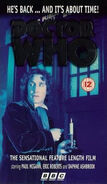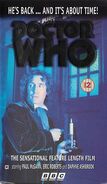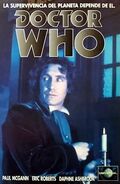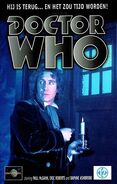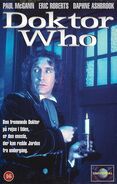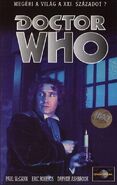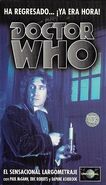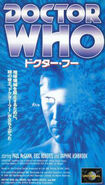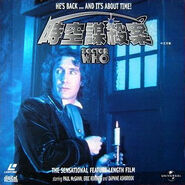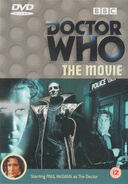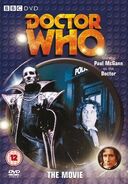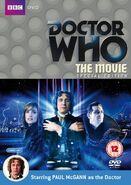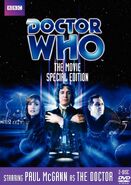- You may wish to consult
Doctor Who (disambiguation)for other, similarly-named pages.
Doctor Who, often also known as The TV Movie, was a made-for-TV movie based on the original series. It was written by Matthew Jacobs, directed by Geoffrey Sax and featured the introductions of Paul McGann as the Eighth Doctor, Daphne Ashbrook as Grace Holloway, Yee Jee Tso as Chang Lee and Eric Roberts as the Master, making Roberts the first American actor to portray an established antagonist in Doctor Who.
It was made as an attempt to relaunch and continue the Doctor Who television franchise in the UK and abroad. With no on-screen title other than Doctor Who, home video releases of the film from BBC Video are marketed under the title Doctor Who: The Movie. The movie featured Sylvester McCoy's final chronological appearance as the Seventh Doctor and his regeneration into the Eighth Doctor. A large period of time is implied to have passed since Survival, as the Seventh Doctor has parted with his companion Ace, is visibly older, is dressed differently and is travelling alone. The TARDIS interior has likewise been revamped, with a brand new console room that did away with the simplistic white roundel design present throughout the show's history.
The story is also the first time that one Doctor's regeneration story also acts as the post-regeneration story for another Doctor. While the beginning of the film focuses on the Seventh Doctor, after he regenerates, the rest of the film focuses on the Eighth Doctor, with parts of the story showing the new Doctor going through post-regeneration issues as past incarnations before him.
This story marked the return of the Doctor's sonic screwdriver for the first time in fourteen years since 1982's The Visitation.
This would be the last televised story of Doctor Who until 2005's Rose, leaving a nine year gap. Even though the movie failed to get Doctor Who renewed as a television series, the series was kept alive through comics, novels and audio stories of the Eighth Doctor's adventures.
The film was co-produced by the BBC and Fox networks. Filmed in Canada, the telemovie introduced McGann as the Eighth Doctor and was his only on-screen performance in the role for 17 years until TV: The Night of the Doctor in 2013. The telemovie won a Saturn Award in 1996 for best television presentation.
Synopsis[]
The Doctor, nearing the end of his seventh life, is charged with transporting the remains of his fellow Time Lord, the Master, back to their home planet. Despite his precautions, his old enemy is not only not dead, but is out for revenge. Creating a timing malfunction in the TARDIS, and bringing the Doctor to San Francisco in 1999, the Master escapes and puts his plans into motion. The Doctor must find a beryllium atomic clock and stop the Master, but after being shot down by members of a street gang, how will he succeed?
Plot[]
As part of a treaty between the Time Lords and the Daleks, Time Lord criminal the Old Master has been placed on trial on Skaro, and is sentenced to extermination for his life of evil. As part of a last, and somewhat curious, request, the Master asked that his old rival the Doctor, now late in his seventh incarnation, escort his ashes back to Gallifrey for proper burial. "It was a request they should have never granted." The Doctor narrates that Time Lords have thirteen lives, but the Master had already used up all his own. However, rules never mattered much to the Master, as he always found a way around them and kept on living. So, even though the Master was dead, the Doctor knew he couldn't trust him.
Fishing a sonic screwdriver out of a tool box, the Doctor locks the urn containing the Master's ashes inside another box. The Doctor smiles, glad to have added a precaution. Narrating again, the Doctor claims he had learnt, by the end of his seventh life, that he could not help but be too careful. After returning to the main control room, the Seventh Doctor sets the TARDIS coordinates for Gallifrey in the Rassilon Era.
Confident that nothing can go wrong now that he's ensured the Master's remains are safely sealed, the Doctor decides to relax on the trip back. Sitting in a recliner, the Doctor enjoys a cup of tea and resumes reading H. G. Wells's The Time Machine, whilst eating a bowl of jelly babies. At the same time, he has "In a Dream" playing on his gramophone.
Nearby, the casket containing the Master's ashes shakes violently. The record begins skipping on the word "time", but the Doctor fixes it, remaining unaware of the situation. The shaking grows worse, causing the record to start skipping worse. The casket breaks open. The Doctor's cup of tea crashes to the ground and the record skips to stop. Realising that he's trying to be told something, the Doctor immediately becomes suspicious of the Master.
A snake-like creature emerges from the box and, unseen by the Doctor, slithers into the TARDIS console. The resulting effect of the console malfunctioning as sparks fly out finally rouses the Doctor: leaving his chair, he rushes to fix it, but is unsuccessful; a critical timing malfunction forces him to make an emergency landing. Concerned that the Master may have had a hand in this, the Doctor quickly returns to where he left the ashes, only to see the box cracked open. The Doctor, shocked, stares at it with a worried expression.
The TARDIS exits the Time Vortex, heading to Earth.
Meanwhile, in San Francisco on December 30th 1999, two local Chinese-American gangs are having a shoot-out, reducing one to just Chang Lee. When the other gangsters prepare to fire on him, the TARDIS materialisation wind picks up and it appears in front of Lee. The gang fruitlessly fire at the TARDIS, emptying their guns. While they reload, the Doctor exits the TARDIS to find his bearings only to be shot by the gangsters, who quickly flee. Lee runs to the Doctor's side. The Doctor tries to warn Lee about the Master, who has slipped through the TARDIS keyhole. However, Lee doesn't turn around in time to see him. The Doctor falls unconscious and Lee quickly runs to get an ambulance and accompanies the Doctor to Walker General Hospital. Unseen, the Master stows away in the ambulance.
At the hospital, a surgeon removes the bullets, but the Doctor's two hearts cause confusion for the medical team. They assume he is fibrillating and that the X-rays showing his two hearts is a double exposure. A cardiologist, Dr. Grace Holloway, is summoned from her visit to the opera, and attempts to stabilise the Doctor's heartbeat. Regaining consciousness, from pre-op sedation by music from the Madame Butterfly opera (which Grace was watching at the theatre), just as she is about to begin the operation, the Doctor tries to prevent it by explaining his non-terrestrial origins and tells Grace that he needs a beryllium atomic clock. Salinger implies that they can't wait any longer to begin the operation, and Grace has the anesthesiologist administer the anaesthetic. However, the Doctor fights the sedation and awakes from it twice, deliriously telling the people in the operating room, "Timing malfunction. The Master, he's out there! He's out there... I've got to stop...him..." The medical team think this is just incoherent babble brought on by the anaesthesia, and attempt to put him to sleep again.
Once the Doctor falls asleep, they insert an endotracheal (breathing) tube in his throat and start their operation to stabilise his heart beat. The Doctor's anatomy confuses Grace, who believes his unusually fast heartbeat is an unwanted and life-threatening fibrillation. She decides to do exploratory surgery to fix it. She gets lost in his right side, which holds a second heart, knowing that she should be in the right side of his body, the surgical team identify his second-heart blood veins as the left side of the heart (the normal human heart parts). Grace attempts to move the microscopic probe in her plan B and accidentally damages his unfamiliar circulatory system with the probe, causing the Doctor's sedated body to have a massive seizure. She is unable to get the probe out when it snaps off inside one of his vital heart vessels, mortally wounding him. The medical team shock his body in attempt to restart his heart. The Doctor's body starts to spasm violently, and he wakes from the anaesthetic one more time, forced into consciousness by the incredible pain he is now feeling. He lets out a final, horribly agonised scream, and collapses on the operating table. The medical team fail to revive the Doctor and they pronounce him dead. Grace takes off her surgical glasses and cap and runs out of the room upset. Wheeler covers the body with the Doctor's surgical drapes.
When Grace tries to comfort Lee with the death of the Doctor, she realises he doesn't know him. Lee runs off with the Doctor's possessions, as Grace cannot run after him in her opera dress. The Doctor is wheeled into the morgue for dissection the next day, with the morgue attendant, Pete, making spa jokes at the dead body.
Around the same time, the Master has hitched a ride to the home of one of the ambulance workers, Bruce, by hiding in his jacket. Bruce snores with his wife, Miranda, in annoyance; she wraps a pillow around her head to block the sound. The Master slithers up to Bruce, quickly shoving himself down the man's throat. Suffocated, Bruce dies; the Bruce Master then gains control of the man's body. Unknowing of this, Miranda assumes Bruce simply stopped snoring and sleeps.
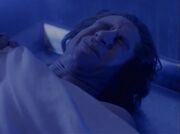
The Doctor reborn into his eighth incarnation.
Later that night, as Pete, on night-shift at the morgue, watches the 1931 film version of Frankenstein, the Doctor comes back to life and, at last, regenerates into his eighth body. His old face twists and warps into the features of a brand new, younger man, followed by a release of dense, foggy breath from his mouth. Surprised and slightly disorientated, he springs up from the gurney and begins banging on the door, attracting Pete's attention. When Pete arrives to see what is the source of the sound, the new Doctor knocks the metal door off its hinges. He is clad in just a shroud, a sight mirrored by the image in the movie. Pete faints in shock while the Doctor stumbles into a deserted wing of the hospital. He walks into a room where he sees himself in broken pieces of mirror. Confused by his new face he falls to his knees and cries out, "Who am I?"
The next morning, the Doctor, after going through numerous hospital lockers, steals the Wild Bill Hickok costume that Pete's co-worker, Ted, intended to wear to the hospital's New Year's Eve costume party. He leaves the costume's gun belt behind though, seeing no use for it. Meanwhile, Chang Lee goes through the Doctor's possessions, finding his sonic screwdriver, pocket watch, jelly babies, a yo-yo, and TARDIS key.
Elsewhere, Miranda awakes to find, unbeknownst to her, the Master staring out the window. As the Master talks to himself about Bruce's body not lasting long and his need to find the Doctor. Happy to see he has a sense of humour and no longer snores, she asks him to come back to bed. The Master turns around, shocking her with the cat-like eyes he acquired on Cheetah World. Miranda attempts to scream in horror, but is grabbed by the neck by the Master, who shushes her. After a moment, he breaks her neck and begins thinking about stealing the Doctor's lives.
At the hospital, the Doctor, still struggling with severe disorientation, hangs out in the hospital reception where he happens to recognise Grace (who has quit her hospital job after an argument with the hospital administrator over covering up the surgery), and follows her to her car, asking for help as he believes she knows who he is. Grace tells the Doctor to leave her alone, convinced he is crazy. She screams when she finds the Doctor in her car in agony. But he removes the source of his pain, the surgical probe which Grace had left in him the previous night, the sight convinces her that this strange man is in fact her supposedly dead patient. She then drives off with the Doctor, at his request, to prevent the hospital staff from killing him again.
"Bruce" goes to the hospital, where he learns that the Doctor died during surgery and that his body is missing and Lee has taken his possessions. Grace takes the Doctor to her house, where she discovers that her boyfriend has left her and taken some of her furniture to boot. She listens to the Doctor's hearts, and takes a sample of his blood, while the Doctor's spotty memory begins to return with anecdotes about Puccini and Leonardo da Vinci. He also explains that he has thirteen lives, going on to say Grace became a doctor because of her childish dream to hold back death; according to the Doctor, she'll do great things. Grace is still sceptical, despite the confirmation of the Doctor’s two hearts.
Elsewhere, Chang Lee uses the TARDIS key to enter the TARDIS. There he encounters the Master, who entered before him. The Master hypnotises Lee into giving him the Doctor's possessions by staring at him with his inhuman eyes. Searching through the bag, the Master demands to know where the Doctor is. Lee says that the items he stole are his now, and that the Doctor is dead. With a snarl, the Master informs Lee that the Doctor is not dead and that he will die unless he finds him. Wondering what he'll get out of assisting the Master, Lee is told he'll get to live. Elsewhere, Grace has given the Doctor a pair of shoes left behind by her boyfriend, letting him keep them; her attempts to examine the Doctor's blood fail. They decide to take a walk, hoping to jog his memory, during which the Doctor happily remembers seeing a wonderful meteor storm on Gallifrey with his father during his initial incarnation. He then joyously announces that his new shoes fit perfectly and runs off happily, much to Grace’s bemusent.
Rummaging through some of the drawers, the Master withdraws some red pouches, going on to say the TARDIS and the Doctor's body were stolen from him. Lee once more says the Doctor died. The Master explains it's half true; that body, the body of the Seventh Doctor, died, but the Doctor regenerated into a new one. He goes on to lie that the Doctor used seven of his lives to commit terrible deeds, claiming Genghis Khan was one incarnation of the Doctor. He then gives Lee the pouches, which contain $5,000,000 in gold dust, as payment for his help, promising a full billion once he gets "his" body back. The Master takes Lee to the Cloister Room, where he uses Lee's human eyes to open the Eye of Harmony, the TARDIS' power source. In the meantime, the Doctor regains his memories. In a fit of enthusiasm, the Doctor announces, "I am the Doctor!" and kisses Grace, who asks him to kiss her again. In the Cloister Room, the Master sees a series of images: the Seventh Doctor, the newly regenerated Eighth Doctor, and a human retina. The latter causes him to announce, "The Doctor is half-human."
The Doctor becomes aware that the Master has opened the Eye of Harmony as he holds Grace; at the same time, the Master and Lee see her through the Doctor's vision. However, the Doctor shuts his eyes, preventing nothing more than audio to come through the Eye's projection. The Doctor explains the Master's plan: he hopes to force the Doctor to look into the Eye of Harmony, which will destroy his soul and allow the Master to take over his body. The Master says the Doctor is lying again; however, Lee is worried Grace might believe him. At the same time, the Doctor asks Grace to help him find a beryllium atomic clock. However, Grace runs back to her house; the Doctor opens his again, but the visual doesn't return to the Eye. The Doctor tries talking to Grace, but she calls him insane and phones for an ambulance to take the Doctor to a mental institution.
To prove that the Eye is open and changing the physical structure of the planet, the Doctor presses against one of the windows, making it bend; he walks through it and into Grace's house. The Doctor explains that at midnight, the entire Earth will be sucked through it unless he can close it in time. Collapsing in shock, Grace asks for two ambulances over the phone. Hearing this, the Master decides to use the identity of his stolen body to commandeer an ambulance, with Lee. The Doctor weighs himself on a scale as Grace's television reports strange weather occurring around the world, which has been caused by the Eye's opening. The Doctor is even more shocked to see he has lost twenty pounds in just the same amount of minutes. Watching a news report, the Doctor hears that a beryllium atomic clock is being unveiled at ITAR. When the ambulance arrives, the EMT is the Master, and the unseen driver is Chang Lee; the Doctor doesn't see Lee or know it's the Master. The Doctor asks to be taken to ITAR. Grace is still sceptical, but indicates for the driver to play along.
As they are being driven, the Doctor questions Grace as to why she didn't tell him she had access to an atomic clock. Still playing along, Grace says she was more worried about what would happen to the Earth if the Eye isn't shut. Their conversation changes subject, in which the Doctor explains he met Sigmund Freud and Madame Curie. However, Lee slams on the brakes at a traffic jam, making the ambulance shake, causing the sunglasses the Master had been using to hide his inhuman eyes to fall off; the Doctor recognises him. Putting his glasses back on, the Master has them pulled back off by the Doctor, who gets out of the way of a burning viscous substance spat by his foe; it lands on Grace's wrist. The Doctor temporarily blinds him with a fire extinguisher, while they flee. They flee into the blocked traffic as Lee cleans the foam off the Master.
A policeman tells them to go back to their vehicles, but the Doctor instead offers him a Jelly baby; sceptical about the sweet, the officer eats it. Grace explains that the Doctor is British to explain his odd habits just as he takes the officer's gun and points it at himself; he demands the officer hand over his motorcycle. The Doctor turns his attention to Grace, who he tells that he cannot make her dream to hold back death last forever, but he can make it come true tonight. Believing the Doctor, Grace takes the gun and shoots the radio, preventing the officer from calling for backup. They take the keys and drive off, leaving the gun behind. At the same time, the Master reminds Lee that they are in an ambulance, which can go past traffic jams if the sirens are on; Lee complies and takes a shortcut to ITAR. The Doctor and Grace arrive shortly after, finding the empty ambulance; the Master and Lee are already inside, waiting for them.
Grace, a board member of ITAR, gets herself and the Doctor inside the party; while looking around for a way to reach the clock, the Doctor explains that time travel is possible and that Time Lords who run out of regenerations, like the Master, are desperate in the fight for survival. She also gives him the alias "Dr Bowman" while introducing him to Professor Wagg, creator of the clock. As the Doctor tells Professor Wagg "a secret" ("I'm half-human, on my mother's side"), he surreptitiously removes Wagg's security pass. Grace and the Doctor steal a small component from the clock, which he needs to repair the TARDIS. They spot the Master and Chang Lee in the crowd, which prompts them to head for the exit. They then find guards that the Master subdued by using the same substance; they are frozen in place, covered in goo. The Doctor activates the fire alarm to "liven things up" as he and Grace make their escape by lowering themselves from the roof with a fire hose.
They flee on the motorcycle, being chased by police and arrive at the TARDIS, where the Doctor remembers that he keeps a spare key in the cubbyhole above the letter "P" in "Police box." One police motorcycle enters the TARDIS and moments later flees in shock, much to the Doctor’s amusement. They enter the TARDIS, where the Cloister Bell is ringing. The Doctor is able to close the Eye of Harmony; however, a quick temporal scan confirms that the Eye has been open too long, and the Earth is still in danger. The only solution is to take the TARDIS back to a time before the Eye was opened — but since the Eye was open so long, the TARDIS now has no power. The Doctor attempts to jump-start the TARDIS by drawing energy directly from the Eye. While working under the console, the Doctor wonders why Grace is not helping as he instructed her to give him his Neutron Ram, looking up to see her eyes have turned black; Grace has been taken over by the Master's will. Grace knocks the Doctor out with a Magnetic Clamp just as the Master and Lee enter the TARDIS.
The Doctor awakens to find himself strapped to a gurney in the Cloister Room. Chang Lee and the possessed Grace chain the Doctor to a balcony, under the supervision of the Master (who has decided to "dress for the occasion" in Gallifreyan robes). Lee explains he'll be rich once once the Master gets his body back. However, the Doctor tells him the Master neglected to mention Earth would be destroyed, making his payment pointless. Per the Doctor's slight manipulation, the Master inadvertently contradicts his earlier lies to Lee by claiming to have used all his lives. Lee now believes the Doctor and refuses to help the Master.
Rather than waste more time by hypnotising Lee again, the Master snaps his neck. The Doctor comments that only Grace is left to open the Eye, but her eyes are not human. The Master taunts the Doctor and removes his influence on Grace as he kisses her, then forces her to look into the Eye. As the Master begins to absorb the Doctor's life energy, the Doctor implores Grace to return to the console room and jump-start the TARDIS.
Several disasters happen all around the Earth as lightning and heavy winds surround the TARDIS; Grace enters the control room as sparks fly out of the console. In the Cloister Room, the Master begins hearing the Doctor's memories and feeling his life force come into him, even briefly taking on his form several times. As the Earth celebrates the approaching new year, Grace manages to start the TARDIS one second before midnight, having remembered the Doctor told her piloting a TARDIS is like setting an alarm clock. The TARDIS enters a temporal orbit, something she needs the Doctor to explain. She returns to the Cloister Room and frees the Doctor, but the Master attacks them both. He throws her off the balcony, killing her. The Doctor and the Master struggle over the open Eye, and the Master falls in; the Doctor attempts to save him, but the Master rejects his hand and is sucked into the Eye.
The TARDIS slips back in time before midnight. Energy travels from the Eye to the bodies of Grace and Chang Lee, reviving them, and the Eye closes. Amused by how sentimental his TARDIS is, the Doctor asks Grace how it felt to hold back death. He then congratulates them, as they've been somewhere he's never been (yet). Grace tells him there's nothing to be afraid of, but wonders if they've gone back far enough. The Doctor tells her that they have or he's talking to a bunch of ghosts, and he doesn't believe in them.
They return to the console room where, through a high-tech dome, the Doctor shows them alien galaxies and his home planet. Lee questions where the Master is just as a grumbling is heard from the TARDIS; "Indigestion," the Doctor remarks. Deciding where to leave them, the Doctor asks if they wish to be deposited back on the 29th of December. While Grace would rather not live through the day again, Lee knows he won't survive it; instead, the Doctor takes them to exactly the first minute of 2000 in a city park.
The Doctor allows Lee to keep the bags of gold dust the Master originally bribed him with, and tells him not to be in San Francisco next Christmas; in exchange, Lee gives back the bag containing the Seventh Doctor's belongings. The Doctor asks Grace to travel with him, but she refuses and asks if the Doctor will stay with her. However, both know he won't and they kiss. Grace thanks the Doctor, but he says "No. Thank you, doctor."
The Doctor leaves in the TARDIS, off to a new adventure. Conducting maintenance on the new part inside the console with his newly recovered sonic screwdriver, the Doctor asks his beloved time machine where it will be they're going this time (as he has no reason to go back to Gallifrey now). He settles back in his armchair in the TARDIS control room to continue reading H. G. Wells' novel The Time Machine. The gramophone record that he is listening to suddenly starts skipping (again). As the TARDIS continues on its flight, all the Doctor says is, "Oh no, not again."
Cast[]

Gordon Tipple dressed as the Master on behind the scenes
- The Doctor - Paul McGann
- The "Old Doctor" - Sylvester McCoy
- Bruce/The Master - Eric Roberts
- Grace Holloway - Daphne Ashbrook
- Chang Lee - Yee Jee Tso
- Salinger - John Novak
- Dr. Swift - Michael David Simms
- Wheeler - Catherine Lough
- Curtis - Dolores Drake
- Pete - Will Sasso
- Gareth - Jeremy Radick
- Miranda - Eliza Roberts
- Motorcycle policeman - Bill Croft
- Professor Wagg - Dave Hurtubise
- Ted - Joel Wirkunnen
- Security Guard - Dee Jay Jackson
- The "Old Master" - Gordon Tipple
- News Anchor - Mi-Jung Lee
- News Anchor - Joanna Piros
Uncredited cast[]
- Dalek voices - Geoffrey Sax (DCOM: Doctor Who)
Crew[]
| Executive Producers Alex Beaton, Philip Segal and Jo Wright |
General production staff
Script department Camera and lighting department |
Art department
Costume department |
Make-up and prosthetics
Movement Casting
General post-production staff
Special and visual effects
Sound |
|
|
|
|
| Not every person who worked on this adventure was credited. The absence of a credit for a position doesn't necessarily mean the job wasn't required. The information above is based solely on observations of the actual end credits of the episodes as broadcast, and does not relay information from IMDB or other sources. |
Production[]
Earliest form[]
After the show had first aired in the United States, American companies had worked hard to purchase the rights for an American version. In the early '80s, when The Walt Disney Company were on their spending sprees, they attempted to buy the rights to the show, meaning the entire franchise would belong to Disney, not just an American version of the show (as early as the mid-1960s, Disney had explored the possibility of adapting TV: Marco Polo and possibly other early stories for its Wonderful World of Disney anthology series). After the broadcast of TV Survival, American entertainment media such as Variety also reported on (or ran advertisements for) proposed feature films based on the series.
Steven Spielberg was Disney's only choice to run the office. Spielberg was more than willing to do it, as he felt that Disney was the only American studio who could do such an amazing British show justice. He lost interest when he was told that the show would be released under their Touchstone Television banner; he felt that such an imaginative show needed to be released under their main Disney banner.
British expatriate Philip Segal had been working since 1989 to forge a co-production deal between an American company and the BBC to make a new Doctor Who series even before the programme's twenty-sixth and final season, broadcast that year. At that time, Segal was working with Columbia Pictures, but little had come of his efforts by the time he left for a two-year stint at ABC. Subsequently, Segal went to work for Steven Spielberg's Amblin Entertainment. Shortly thereafter he resumed his efforts to acquire the rights to Doctor Who.
By June 1992, he was joined by Peter Wagg, producer of the eclectic science-fiction series Max Headroom. There were several parties involved in the Doctor Who discussions: Amblin and the BBC, of course, but also Amblin's parent company, Universal Pictures, and the BBC's commercial arm, BBC Enterprises, which would shortly become BBC Worldwide. With each organisation trying to safeguard its own interests, negotiations stretched into 1993, and then 1994.
Despite the many difficulties the complex situation presented, on 13 January 1994, an agreement was reached. Philip Segal was, for all intents and purposes, Doctor Who's newest producer. The race was on to get a series ready to be pitched to the American networks in time for the Fall 1994 season, essentially giving Segal and Wagg less than two months.
One of Segal's first instructions from his superiors at Universal was to use a studio writer for the project, specifically John Leekley. Segal was hesitant, preferring to go outside Universal; former Doctor Who script editor Terrance Dicks was amongst the candidates he considered. However, aware that any fight with Universal would waste precious development time, Segal agreed to bring Leekley aboard.
As a TV series[]
With designer Richard Lewis, Segal and Leekley prepared an expensive and extensive series bible, The Chronicles Of Doctor Who?, to introduce Doctor Who in general, and the proposed new series in particular. Segal had envisioned this version as largely divorced from the original BBC series — although the basic concepts of Doctor Who were adhered to, the programme's mythos would be completely rewritten. The bible was written from the perspective of Cardinal Barusa (a misspelling of Borusa, a character who had first appeared in Season Fourteen's The Deadly Assassin).
It introduced the Doctor and the Master, half-brothers and sons of the lost Time Lord explorer Ulysses, Borusa's son. When the evil Master becomes President of the Time Lords upon Borusa's death, the Doctor flees Gallifrey in a rickety old TARDIS to find Ulysses. Borusa's spirit becomes enmeshed in the TARDIS, enabling Borusa to advise his grandson. The Doctor takes the TARDIS to "the Blue Planet" to search for Ulysses, the native world of the Doctor's mother.
They soon searched for the man to play the Doctor. Many people were considered and auditioned, including Rowan Atkinson, Derek Jacobi, and Jim Carrey. During a 2014 promotional event, Peter Capaldi confirmed he was invited to audition, but declined.
It was under this script that Paul McGann later would audition. His brother Mark would as well.
A movie is formed[]
Through mid-September, Leekley's script made the rounds of all the various organisations which had to approve it (Amblin, BBC Television, BBC Enterprises, the Fox network and Universal). Ironically, the death knell was sounded by Segal's own boss, Steven Spielberg. Spielberg was concerned that Leekley's script veered too closely to his own Indiana Jones franchise, and on 26th September asked Segal to start again with a new writer. This meant that principal photography would be delayed until at least February 1995.
The BBC, particularly BBC1 Controller and longtime Doctor Who supporter Alan Yentob and Tony Greenwood of BBC Enterprises were still enthusiastic about Doctor Who and around the start of October, at the instigation of Universal, Segal met with veteran writer/producer Robert deLaurentis. DeLaurentis agreed to put together a new story proposal, using Leekley's script as a starting point but wanted to accentuate its "fun" aspects.
On 7 October, DeLaurentis delivered a new draft of the storyline. This time, in the process of meeting Lizzie in World War II London, the Doctor also discovers that his father (no longer named Ulysses) was involved in a plot to assassinate Hitler. They travel forward to the United States in 1994, where the Doctor is reunited with his father. The Master lures the Doctor, his father and Lizzie to Skaro for a final confrontation. There, the Doctor destroys the Master's time-travelling warship, though the Master himself escapes with his Daleks. Other minor alterations included Castellan being renamed Casteloan (though this would subsequently be changed back), and giving Lizzie a bulldog companion named Winston, who stays with the Doctor at the story's conclusion.
A third producer joined the Doctor Who team in March, much to the surprise and, at the time, the dismay of Segal. This was Jo Wright, assigned by the BBC to represent their interests. Around the end of March, Doctor Who was offered to the four American networks. NBC and ABC were completely uninterested. CBS president Peter Tortorici tentatively offered Segal a two-hour pilot and six one-hour episodes (presumably to serve as mid-season replacement series), but this was retracted by network head Howard Stringer in mid-May.
That left Fox, at the time still the youngest American network. Led by head of series Robert Greenblatt, Fox was interested in Doctor Who, but was only willing to commit to a two-hour movie with the possibility of a second. It appeared Segal's dreams of producing a new Doctor Who series were fast disappearing. Despite this, he agreed to an offer made by Doctor Who historian Jean-Marc Lofficier and his wife Randy to become unofficial consultants on the project.
At the suggestion of Trevor Walton, Fox's vice president in charge of movies, Segal and Wagg met with Matthew Jacobs, who had written for The Young Indiana Jones Chronicles. (Jacobs was the son of Anthony Jacobs, who had played Doc Holliday in The Gunfighters, and had been present on the set.) The selection was approved by the other interested parties and Jacobs set to work on 5th May. Unlike the DeLaurentis iteration, it was decided to essentially discard all the work done to date, with Jacobs starting afresh on an entirely new script. Only the idea of the Doctor having a human mother would be retained.
By 19th May, Jacobs had composed a storyline; unlike the earlier Leekley and DeLaurentis versions, this continued from the end of the original series, starting by introducing Sylvester McCoy's Seventh Doctor. The Doctor arrives on modern-day Earth in either San Francisco or New Orleans.
However, the dying Master has transmogrified himself into a shape-shifting slick of DNA, and attacks the Doctor, mortally wounding him. The Doctor's body is found by a street kid named Jack. Jack brings the Doctor to the hospital, where he is operated on unsuccessfully by Dr Kelly Grace (an obvious play on the name of actress Grace Kelly). In the morgue, the Doctor regenerates; meanwhile, the Master acquires a temporary human host body. Jack has gained access to the TARDIS using gloves he has pilfered from the Doctor's body. The Master raises Jack's father from the dead and through him uses Jack to take over the TARDIS.
As Halloween approaches, the Master uses the TARDIS to unleash an army of the dead. With Kelly's help, the Doctor returns to the TARDIS and draws himself, the Master, Kelly, Jack and the dead into another dimension. He defeats the Master, returns Jack to Earth and leaves with Kelly.
Various changes were made by the time of the next draft, on June 27th. The date was shifted to the days leading up to New Year's Eve instead of Halloween, and San Francisco was specified as the location. After regenerating, the Doctor sees a vision of his mother. Jack uses the TARDIS key instead of a pair of gloves to enter the time machine. In addition to Jack's father, Kelly is also confronted by someone from her past, and an earlier suggestion made by Jacobs that Jack be killed only to be brought back to life via the power of the TARDIS was included. Kelly also reluctantly remained behind at the end of this version.
At this stage some of the key crew positions started to be filled, most notably British director Geoffrey Sax, whose work included episodes of Bergerac and Lovejoy. Because the movie would be filmed in British Columbia, Canadian regulations meant that most of the rest of the crew would come from the country. This included production designer Richard Hudolin, whose major task was a redesign of the TARDIS console room. Segal wanted to invoke the Jules Verne feel of the wooden version of the set used during Season Fourteen, but on a much grander scale.
Construction on the TARDIS sets began very early on, during September, before the project had even been officially green-lit. Around the start of October, Fox announced Doctor Who would air in mid-May 1996. May was one of three key "sweeps" periods for the American networks (the others falling in November and February), when ratings performance determines advertising rates for the next quarter. Consequently, expectations for Doctor Who would be fairly high.
The next step was to cast the major roles. Sylvester McCoy had already agreed to appear, fulfilling a promise he had made to himself in 1989 to hand off the role of the Doctor to a successor in proper fashion. Jo Wright, in fact, had wanted Fourth Doctor Tom Baker to appear instead, but Segal was adamant that the telefilm continues from where the original series had left off.
Segal also briefly considered the idea of including a role for Sophie Aldred as Ace, the Seventh Doctor's final companion. This, however, was quickly vetoed by the BBC. Segal did decide to give the Seventh Doctor a new wardrobe, having long disliked the umbrella and the question-mark pullover which were hallmarks of the original outfit. McCoy, similarly, had detested the pullover. Costume designer Jori Woodman composed a new costume which echoed the earlier version but was much more refined; to Segal's delight, McCoy brought with him a hat he had worn during his time on Doctor Who.
With production just weeks away, Jacobs was working on fashioning his script into a finished form. The BBC was much more receptive to his November draft, but passed it along to an in-house script editor, Craig Dickson, for comment. From this came the decision to eliminate the Millennium Star concept, with the Master's focus now simply to take over the Doctor's body.
Jacobs' newest draft was ready by 29th December, and this was fundamentally the version which was recorded. Other small changes eventually made included changing Grace's surname from Wilson to Holloway; eliminating the Bill And Ted reference (which the BBC felt was out-of-date) by renaming the former Pete; having the Master break Bruce's wife's neck instead of shooting her; and excising a scene where the Master callously kills a hospital patient who resembles the Seventh Doctor. Much of Chang Lee's background had also been lost to timing issues by this stage, with all references to Sam and Jimmy Lee being dropped.
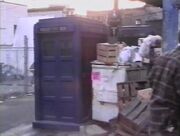
2 Police Box props. (DOC: Bidding Adieu: A Video Diary)
As 1996 dawned, numerous difficulties still remained to be overcome. Geoffrey Sax had originally been promised a luxurious thirty-day shoot, but Beaton subsequently curtailed this to twenty-five days to save money. Then Segal discovered that the BBC did not actually own the rights to the familiar Doctor Who theme music; this rested with Warner/Chappel Music, who wanted to charge a hefty fee for its use. Universal baulked at this, but finally Segal convinced the BBC to pick up the cost. The new theme arrangement would be composed by John Sponsler and John Debney. Segal had not realised that McGann had recently cut his hair severely for another production until McGann arrived in Vancouver for a photo shoot on 7th January; this meant that hair stylist Julie McHaffire had to hastily put together a wig.
Filming begins[]
Location filming began on 15 January and was interlaced with the studio work which started on the 31st. Sites around Vancouver were used, including a disused wing of the BC Children's Hospital, the Plaza of Nations and several street exteriors; no filming was actually carried out in San Francisco; for establishing shots, stock footage was employed. The studio itself was located in nearby Burnaby.
Some difficulty arose when Roberts found the wardrobe created for him by Woodman, which was largely in keeping with the Master's outfits from the original series, was too restrictive. He was also uncomfortable with the serpentine contact lenses he was supposed to wear and with the prosthetics which would have depicted his body's gradual disintegration over the course of the movie.
The result was that the effect of Bruce's body wearing out was essentially lost and it was decided to instead dress Roberts in dark sunglasses and a leather jacket for most of the film, unfortunately turning the Master into a silhouette of the Terminator from the two Arnold Schwarzenegger motion pictures. Elements of the Master's original costume would still be visible in the Time Lord outfit he wears in the later stages of the movie.
Several other issues had to be confronted as the shoot went on. Some problems were found with the script such as the question of how the Master has gotten into the TARDIS when he first encounters Chang Lee, which had to be simply ignored. The final battle between the Doctor and the Master had been only briefly sketched and had to be quickly fleshed out for filming.
Sax had hoped to have all the Doctors appear in the Eye of Harmony, but could not get clearance on the images in time. Ultimately, the production went four days over schedule; even then some sequences were greatly simplified to save time, such as Chang Lee's death scene. Filming for Doctor Who was completed on 21 February.
Post-production saw trims to the material, such as the loss of the scene where the Master confronts the security guards who are later found "slimed". The Dalek voices were originally in keeping with the original series, but were changed over concerns they weren't audible enough. (Later, in 2013, Sax would say that he wished he had employed Nicholas Briggs for the Dalek voices, and that he would consider employing Briggs for future home video releases.) A new introductory voiceover by Paul McGann was written on 2 April to replace earlier dialogue by the Master (voiced by Gordon Tipple) and the Daleks. The BBC expressed concerns the Master's snake form was too comical, but little could be done about it at this stage. Segal lent a rough cut of the movie to Los Angeles-based fan Shaun Lyon, organiser of the Gallifrey One conventions and editor of the Outpost Gallifrey website, to get his opinion. It was Lyon who caught several errors in the movie, most notably a reference to the Doctor having twelve lives. This was amended to the correct number, thirteen.
Segal also had to deal with various claims for credit from individuals who had worked on earlier stages of the project. Despite the protests of Fox and Universal, Segal won agreement for John and Ros Hubbard to be credited, as they had indeed been the first to bring McGann to his attention. John Leekley's case for a producer's credit was rejected, however, because virtually nothing remained of his work.
Meanwhile, the various cost overruns on recording, casting and even the theme music, all to the tune of roughly US$170,000, was creating animosity between the coproduction partners, souring the relationships before the would-be back-door pilot had even aired.
After filming, the cast were never called again. Most of the props were put in storage, including the main TARDIS console piece. The console was later saved from destruction by Doctor Who fan Paul J. Salamoff, who reconstructed the column and currently lets fans and ex-actors alike visit it freely. Paul McGann, Daphne Ashbrook and Yee Jee Tso are three people to have been known to visit.
Worldbuilding[]
Foods and beverages[]
- In the TARDIS, the Seventh Doctor has a bowl of jelly babies, together with a cup of tea and The Time Machine by H. G. Wells.
- Grace takes a glass of champagne at Professor Wagg's party.
Gallifrey[]
- "Rassilon Era" appears on the TARDIS' console and screen.
- The Seal of Rassilon is featured extensively throughout the TARDIS.
- Carvings of Rassilon's head are used extensively in the Cloister Room.
- The Master uses the Eye of Harmony to spy on the Eighth Doctor and in an attempt to transfer his lives.
Individuals[]
- The Master, the Eighth Doctor and Grace mention Marie Curie, Sigmund Freud, Leonardo da Vinci, Puccini and Genghis Khan.
- Grace likes Madame Butterfly, and the Doctor has met its composer. He tells Grace that Puccini had died before he finished, meaning someone had to finish it based on Puccini's notes.
- The Seventh Doctor's x-ray reveals the presence of two hearts.
- Both the Master and the Eighth Doctor state that the Doctor is half-human, with the Doctor claiming it's "on [his] mother's side".
- The Doctor remembers to have watched a meteor storm with his father during his first incarnation.
- The Seventh Doctor "dies" late on Dec. 30, 1999, while he regenerates into the Eighth Doctor early on Dec. 31, 1999. This marks the first time exact calendar dates are given for the Doctor's regeneration (previously, the First Doctor was only known to have regenerated sometime in 1986. (TV: The Tenth Planet)
Technology[]
- The Eighth Doctor wishes he had his sonic screwdriver with him, which is in Chang's possession at the time he mentions this.
- The Eighth Doctor also asks Grace for the neutron ram.
- The Eighth Doctor describes the chameleon circuit to Grace as a cloaking device, but he admits he likes the TARDIS as a police box.
- Grace uses opera glasses.
The Doctor's TARDIS[]
- The odd-shaped TARDIS key, last used by the Fourth Doctor, appears. The Yale lock opening seen on the door slides away to reveal a keyhole underneath, which this key fits.
- There is a small cubbyhole in the P in Police in the sign above the doors, in which the Doctor keeps a spare key.
- The Eighth Doctor states that his TARDIS is "a Type 40 TARDIS, able to take you to any planet in the universe, and to any point in that planet's existence."
- The Master, with Chang Lee's help, opens up the Eye of Harmony.
Other[]
- Along with "Rassilon Era", another era that appears in the TARDIS display is Sumaron Era.
Story notes[]
- The telefilm features a redesigned console room with a library and Gothic architecture. Although this attracted criticism from some fans, in TV: Time Crash, it would be established that the console room design can be changed like a desktop theme. TV: The Masque of Mandragora previously also established that the TARDIS has more than one console room, and TV: Logopolis established that the interior can be reconfigured.
- The Rassilon carvings were based on Richard Mathews' likeness (In-Vision #108: The TV Movie).
- For The Nth Doctor, the tele-movie producer Philip Segal approves of the subtitle "Enemy Within" to help distinguish it from the unproduced movies also named "Doctor Who". However, this name was never used in any official capacity, at any stage of production. The story's title was always Doctor Who.
- British-born television producer Philip Segal had a longtime ambition to produce Doctor Who. While working at various American production companies, including Steven Spielberg's Amblin, he attempted to develop a Doctor Who series or film. Eventually he arranged a co-production between Universal Pictures and the BBC. The script went through several different forms, including some which would have taken place on Gallifrey or during World War II.
- The eventual script by Matthew Jacobs continued from the BBC series, including a substantial role for Sylvester McCoy, the previous actor to play the Doctor.
- For the international release, the opening sequence within the TARDIS has the caption "Based on the series originally broadcast on the BBC". It is standard practice for American productions to give screen credit to a series/character creator, so this title card is used in lieu of crediting Sydney Newman or any of the others involved in the creation of the original series. Contrary to later practice, Terry Nation does not receive screen credit for the Daleks, who are referenced and heard but not seen. Further in line with American practice is the billing of the main cast in the opening sequence, a custom that would be reappropriated for the 2005 revival series after opening billings were adopted by British television.
- At the time of broadcast, there was significant controversy over the Doctor kissing Grace, as this was the first overtly romantic scene involving the Doctor. Daphne Ashbrook recalled in The Doctors Revisited - The Eighth Doctor how this severely hampered her intentions of flying to Britain for a convention. The later revival series, however, would incorporate more of these elements, with Steven Moffat jokingly stating in the same documentary that "puberty had come for the Time Lord" during this story.
- Promotional advertisements for the telefilm shown on the Fox network incorporated footage from the opening sequence of the first episode of The Trial of a Time Lord — specifically the TARDIS being drawn into the giant space station — even though this footage does not appear anywhere in the telefilm. The arrangement of the Doctor Who theme heard during these ads doesn't correspond with the Debney arrangement heard in the film, either.
- Neither Paul McGann nor Sylvester McCoy are actually credited on-screen next to any character name. However the press kit for the film gives the official credits as being as "The Doctor" and "The Old Doctor" respectively — and these are also the credits given in Radio Times.
- The version of 1931's Frankenstein excerpted here is not the current restored version, but the earlier censored print that was commonly circulated on TV prior to the 1980s; this is evident from the fact Dr. Frankenstein's dialogue, "Now I know what it feels like to be God", is not heard in the scene shown during the regeneration sequence.
- Sylvester McCoy has in recent years been critical of aspects of this film, telling the premiere episode of Doctor Who Confidential that the film should not have featured him, but should have started with Paul McGann's Doctor and saved the story of how the regeneration occurred for an episode of the resulting series, if one had been commissioned. This scenario eventually happened with the Eighth Doctor in the revived series, whose regeneration was not seen until 2013 - eight years after the Ninth Doctor's debut.
- This is the first televised Doctor Who to feature original narration (one of the characters addressing the audience in voice-over) since TV: The Deadly Assassin. In this instance, the Eighth Doctor sets the scene during the pre-credits sequence and immediately thereafter.
- It was originally intended that the opening narration would be by the Old Master, requesting that the Doctor transport his remains back to Gallifrey. Although Gordon Tipple recorded this voice-over, it was never used in the final version of the TV Movie, being cut out in favour of Paul McGann's narration. Tipple retained an on-screen credit, despite only appearing in the opening scene where he had no dialogue; his face was totally obscured by shadows, causing eternal fan debate over whether Tipple's Master was a separate incarnation or just a recasting of Anthony Ainley. According to DWM 497, it is Tipple's eyes that are featured in close-up during the opening credits.
- Radio Times credits Bill Croft (Motorcycle Policeman) as "Motorcycle Cop", Dee Jay Jackson (Security Guard) as "Security Man", and Joanna Piros (News Anchor) as "Co-anchor".
- According to press coverage at the time, the redesigned TARDIS console room set cost $1 million to build.
- This is only one of two Doctor Who stories shot entirely on film, the other being TV: Spearhead from Space. Additionally, this is the only Doctor Who story to be entirely shot on 35mm film.
- The original script called for Bruce's body to start visibly decaying after the Master's possession; this was later dropped when the prosthetics caused Eric Roberts severe skin irritation. The only remaining aspect of this subplot is during the hospital sequence when Bruce removes a fingernail.
- In the original script, the Doctor's father was referenced and named "Ulysses", a plot element later taken up in some of Eighth Doctor Adventures novels, most notably PROSE: The Gallifrey Chronicles.
- Fox originally aired the movie in a standard two-hour (120-minute) timeslot, meaning it aired with approximately 35 minutes worth of commercial interruptions. As a result, it is sometimes erroneously listed as the longest single "episode" in Doctor Who history, but that title is still held by the 90-minute TV: The Five Doctors.
- Because it was the only full-length TV story featuring the Eighth Doctor, the Doctor Who telemovie was rebroadcast on 31 August 2013 on BBC America alongside the special The Doctors Revisited - The Eighth Doctor. It also aired in the United Kingdom later in the year on 3 November, along with the Revisited special.
- This is, to date, the only story in the Doctor Who franchise to be primarily produced by an American company.
- This story features the first instance of the Doctor regenerating outside the TARDIS in which they do so without any external assistance.
- The tools from the Doctor's toolbag are visibly based on the TARDIS Tool Kit from REF: The Doctor Who Technical Manual using the moog drone clamp, pen torch, laser, neutron ram, magnetic clamp, master drone clamp and stalog gyro.
- Following the Dunblane massacre, the movie was edited on its original BBC transmission to remove as much of Chang's friends getting shot as possible — as a result of this editing, Chang's friends appear to simply vanish in the broadcast version. The Seventh Doctor's dying scream was also deemed to be too much and also removed. The VHS release was also edited; UK viewers saw the uncut version for the first time in November 1999 when the movie was repeated on BBC Two for a Doctor Who theme night. These scenes were also reinstated on the DVD release of the episode, but the sound effects of the Master breaking Miranda and Chang Lee's necks (which were also removed on the original transmission) were still omitted. The edited version would then become available on BBC iPlayer in 2023.
- In order to cast Paul McGann as the Doctor, Philip Segal had to agree to cast a name actor as the Master. Hence why Eric Roberts was cast.
- Sylvester McCoy's small part in the film can be chalked up to the fact that the higher-ups at the BBC (namely controller Jonathan Powell) saw him as synonymous with the show's decline in quality. His participation was approved so long as he didn't say or do anything.
- In one interview, Paul McGann and Daphne Ashbrook described Eric Roberts as standoffish, rude (making personal remarks about McGann being "effeminate"), and sometimes "amazingly bad".
- The costume designers were unable to get any of the costumes Sylvester McCoy wore as the Seventh Doctor, but luckily the actor still owned the hat. Philip David Segal had never liked the Seventh Doctor's umbrella with the large red question mark-shaped handle, and so this item was not reintroduced.
- Paul McGann had just shaved his head to play an SAS officer for another made-for-TV-movie, The One That Got Away. He had hoped to be the first Doctor to have a shaved head, but he was overruled, so he had to wear a wig.
- The hospital sets used for this film were also used by the producers of The X-Files.
- Michael Apted, Joe Dante, Alan Parker, Ridley Scott and Peter Weir were considered to direct the movie before Geoffrey Sax was hired.
- According to Sophie Aldred, Ace was considered to appear, but it was decided that explaining the concept of the Doctor to a new audience was complex enough without introducing the companion. Furthermore, she was busy with presenting work, although she said she would have dropped in a heartbeat in favour of returning.
- Alan Menken was considered to write a new theme tune before John Debney was hired when the producers couldn't secure the rights to the familiar theme. Nonetheless, Debney ended up creating an arrangement of the theme anyway for both the opening and closing credits, albeit Ron Grainer was not credited.
- The original storyline began with the Seventh Doctor arriving on modern-day Earth. However, the dying Master had transmogrified himself into a shape-shifting slick of DNA and attacked the Doctor, mortally wounding him. The Doctor's body was found by a street kid named Jack, who brought the Doctor to the hospital, where he was operated on — unsuccessfully — by Dr Kelly Grace. In the morgue, the Doctor regenerated, seeing a vision of his mother after doing so. Meanwhile, the Master acquired a temporary human host body. Jack gained access to the TARDIS using gloves he pilfered from the Doctor's body. The Master raised Jack's father from the dead, and through him compelled Jack to take over the TARDIS. As Hallowe'en approached, the Master used the TARDIS to unleash an army of the dead. With Kelly's help, the Doctor returned to the TARDIS and drew himself, the Master, Kelly, Jack and the dead into another dimension. He defeated the Master, returned Jack to Earth and left with Kelly.
- In another draft, the Master became more reptilian and was able to control his form, turning his arms into lassos at one point. The Eye of Harmony served as the link to the Master's death dimension. Chang Lee now saw his late father, Jimmy Lee, reflected in the Eye, and Grace later had a vision of her grandmother. Chang Lee acquired an uncle, Sam, who was killed by the Master. This time, after all four passed through the Eye of Harmony, the Doctor saved Grace and Chang Lee (who was still killed and then resurrected) by embracing his past after conjuring up the ghost of his dead mother. The Master tried to repeat the Doctor's feat, and was destroyed. The Doctor travelled on alone, leaving Grace and Chang Lee in San Francisco. This version also featured a pair of comic relief porters named Bill & Ted (who were eliminated for being too dated a reference and were combined into Pete) and a librarian named Gareth (who in a later draft was a representitive for a company that made clocks).
- At one point, the Master's schemes involved an “intergalactic roving force field” called the Millennium Star which passed near Earth every thousand years. The Master intended to use the Eye of Harmony to harness the power of the Millennium Star, permitting him to refashion the universe. The Master posed as a “false messiah” in order to influence Grace and Chang Lee.
- When Chang looked into the Eye, he was originally supposed to see images of all the previous Doctors. Rights issues prevented this, although it was reinstated in Gary Russell's novelisation.
- The Master originally shot Bruce's wife and in a deleted scene callously killed a hospital patient who looked like the Seventh Doctor.
- New Orleans was an alternate setting.
- Bruce was originally a fireman.
- Philip Segal originally wanted Stacy Haiduk for the role of Grace Holloway, having known her from seaQuest DSV. Maria Bello, Marcia Gay Harden, Helen Hunt, Carrie-Anne Moss, Paige O'Hara, Nia Peeples, Mia Sara and Helen Slater were considered before Daphne Ashbrook was cast.
- Sylvester McCoy revealed that during the sequence where the Doctor locks the casket with his sonic screwdriver, he held the tool pointing the wrong way around (although in the original series, it is seen being used both ways). The prop was blurred in post-production to conceal the error.
- Grace's surname was Wilson at one point.
- The Institute for Technological Advancement and Research was originally KAL-Tech.
- Professor Wagg was a tribute to producer Peter Wagg, who was involved in the project for a while.
- At Eric Roberts' request, his wife Eliza was given the minor role of Bruce's wife, Miranda. His young daughter Emma would also be present during production.
- Paul McGann was joined in Vancouver by his agent, Janet Fielding.
- Geoffrey Sax had originally been promised a thirty-day shoot, but Alex Beaton subsequently curtailed this to twenty-five days in order to save money.
- Finances were also a concern when Philip Segal discovered that the rights to the theme music were not owned by the BBC, but by Warner/Chappel Music. With great reluctance, Universal agreed to pay the hefty fee for its use.
- Richard Hudolin's TARDIS set was so massive that only a fraction of it would be seen onscreen. Enormous detail went into the design -- everything from busts of Rassilon visible in the cloister room, to a roundel-type design on the main doors which would echo the look of the original console room. Every control on the main console actually did something, and the rotating panels which indicated the current location and era made numerous references to lore, including the Sensorites, the Kraals, Calufrax, Argolis, Manussa and the Sumarans, and Sarn. However, Geoffrey Sax was concerned about the set because he had had little input into its design. Some of Hudolin's decisions, such as placing the Eye of Harmony on a rostrum, would restrict his choice of camera angles.
- The Master was originally supposed to wear an outfit reminiscent of Roger Delgado, but Eric Roberts found it too restricting. He also hated the serpentine contact lenses he had to wear.
- Recording at the Plaza of Nations overran so badly on the second day that Geoffrey Sax had to abandon some elements of the Doctor and Grace's escape from the ITAR building, because dawn was breaking. The scene in the stairwell replaced them.
- Sylvester McCoy was accompanied to Vancouver by Mark Gatiss, who was recording Bidding Adieu: A Video Diary.
- Filming at Columbia Children's Hospital was confined to a wing which was slated to be demolished; as such, the heat was turned off, resulting in frigid conditions.
- The traffic jam was originally supposed to be caused by a runaway circus. Due to budget constraints, this was changed to escaped chickens.
- Filming the Doctor's farewell to Grace was hit by heavy rain, which caused Paul McGann's wig to fizz.
- In addition to playing the Master during his trial, Gordon Tipple was originally supposed to provide the opening narration in character.
- With the shooting schedule in tatters, Geofrey Sax focussed on finishing up scenes involving the Master; as the highest-paid actor, Eric Roberts would inflate the cost of any overruns for which he was required. As such, some scripted elements were simplified. For example, Chang Lee originally broke his neck when he was hurled across the cloister room by the Master. Several narrative issues, such as the question of how the Master had gotten into the TARDIS when he first encountered Lee, simply had to be ignored.
- Philip Segal loaned a rough cut of the movie to Shaun Lyon, who caught several dialogue errors, most notably a reference to the Doctor having only twelve lives, rather than the appropriate thirteen.
- The Dalek voices, provided by Geoffrey Sax himself, were meant to be in keeping with those heard in the original series, but were changed due to concerns that they weren't sufficiently audible for an American audience.
- Post-production saw various trims to the material, including the loss of the scene where the Master confronted the security guards who were later found “slimed”. The violence in the shootout was reduced, with Chang Lee no longer reloading and returning fire.
- Paul McGann was reluctant to sign on, as he was wary of the prospect of spending several years in the United States should a new series result. He finally committed to the production just two weeks before the start of filming.
Ratings[]
Awards[]
- At the 1997 Saturn Awards ceremony, Doctor Who took home a statuette for "Best Single Genre Television Presentation", and Paul McGann was nominated in the category of "Best Genre TV Actor".
Filming locations[]
- This is the only story ever to be filmed primarily in Canada.
- The story was filmed in Vancouver, British Columbia, Canada from 15 January to 21 February 1996. This was the first Doctor Who production mounted completely outside of the UK, and the last to be mounted in a major way outside Europe until the production of Planet of the Dead in the Middle East in 2009.
- Ogden Avenue (No 1998), Vancouver, Canada
- Plaza of Nations, Vancouver, Canada
- East Georgia Street (No 218, rear), Vancouver, Canada
- Keefer Street (No 222), Vancouver, Canada
- Carrall Street/Keefer Street, Vancouver, Canada
- Waterfront Road, Vancouver, Canada
- Hadden Park, Vancouver, Canada
- British Columbia Children's Hospital, 4480 Oak Street, Vancouver, Canada
- East Georgia Street (alley), Vancouver, Canada (Alley where the TARDIS materialises)
- Golden Crown Centre (car park), 211 East Georgia Street, Vancouver
- Andy Livingstone Park, Vancouver, Canada
- Eastlake Drive (no 8651), Burnaby, Canada (Location of studio)
Production errors[]
- During the opening sequence, the red glow surrounding Skaro can be seen to "leak" at the absolute bottom of the screen. As most 20th-century televisions had an area of overscan, this error would likely not have been caught during editing or transmission.
Continuity[]
- The Doctor has a toolbag containing some of his tools such as the one used against Omega's fusion booster, (TV: Arc of Infinity) a magnetic clamp, a laser cutter and a magnetic drone. (TV: Earthshock)
- The Decayed Master previously attempted to use the Eye of Harmony to give himself a new set of regenerations. (TV: The Deadly Assassin)
- The Master states that the Doctor made him waste all his lives. (PROSE: The Dark Path)
- The Cloister Room is revisited. (TV: Logopolis)
- Pete watches the 1931 film version of Frankenstein as the Doctor undergoes his seventh regeneration. The First Doctor encountered an android version of Frankenstein's monster at the Festival of Ghana in 1996. (TV: The Chase)
- Death previously taunted the Doctor by telling him that his seventh incarnation would die without warning, without purpose, afraid and alone. (PROSE: So Vile a Sin)
- An alternative version of the Doctor settled down in San Francisco and eventually married Grace. (PROSE: So Vile a Sin)
- While the Doctor and Grace are escaping from Chang Lee and the Master via a ladder and fire hose, the Doctor cites a fear of heights. His fourth incarnation regenerated after a fatal drop from the Pharos Project telescope. (TV: Logopolis)
- When the TARDIS temporarily stops working, the Doctor "fixes" it by hitting the console. (TV: The Five Doctors)
- The Doctor has a Nine Hundred Year Diary, similar to the Five Hundred Year Diary he previously kept. (TV: The Power of the Daleks)
- The Doctor previously met H. G. Wells. (TV: Timelash)
- The Master would later make another attempt at stealing the Doctor's body and succeed, though only temporarily. (TV: The Power of the Doctor)
Home video and audio releases[]
Despite the fact that the 1996 tele-film was made for American broadcast, it was until 2011 the only non-missing story which had not received a North American home video release in any format. Joint BBC/Universal ownership was problematic for North American publication, because the BBC are obliged to use Warner Brothers, and not Universal, for their Doctor Who DVD distribution. In August 2010 it was announced by Dan Hall, the commissioning editor of the Classic Doctor Who DVD range, that Universal had agreed on the release of the TV Movie outside the UK (including North America).
Release finally occurred on 8th February 2011. The 2011 US DVD release is an unfortunate victim of back-and-forth conversion issues - the film was converted to PAL for its UK release, resulting in an approximate speed increase of 2% as well as some frame-blending (to the credit of the Doctor Who Restoration Team, much of the frame interlacing was removed by hand). However, this was then converted back to NTSC for the US DVD release, resulting a loss of picture quality compared to if production had been allowed to simply rescan the NTSC master and use that as the basis for the US release.
Several of the featurettes on the 2001 UK DVD were produced specifically for US audiences, and provided British home audiences with a look into the way Doctor Who was marketed in America.
Some snippets of footage from the movie had made their way onto certain US releases. In 1999 the charity spoof The Curse of Fatal Death, which reused a short snippet of the TARDIS in flight from the TV movie, was released to UK and US audiences on VHS. In 2003, a special 40th anniversary music video that included footage from the film was added to a number of classic-series Region 1 DVDs. In July 2009, the Region 1 DVD release of Planet of the Dead included an unedited edition of Doctor Who Confidential that includes part of a dialogue scene from the film. The Next Doctor, also released to DVD in Region 1 in 2009, includes a short piece of footage from the film.
A special edition DVD release was released 2010 in the UK as part of the Revisitations box set, with additional special features. It is this version that was also released to North America/Region 1 in February 2011.
In 2016, the movie was released on Blu-ray. Again, this was sourced from the same PAL rescan and clean-up used for the 2010-2011 DVD release. As a consequence, this story is unique among non-missing Doctor Who TV stories in that it has never been released at the framerate and dimensions for which it was initially produced.
VHS releases[]
This story was released as Doctor Who.
It was released:
Note: This story was released in an edited form with the operating room and gun battle sequences trimmed; the latter was considered to be inappropriate in light of the shootings that took place at the primary school in Dunblane, Scotland, earlier that year.
Laserdisc[]
DVD releases[]
2001[]
Released to DVD in the UK as Doctor Who: The Movie, this release was the fourth release of 2001.
It was released:
Contents:
- Philip Segal's Tour of the TARDIS - Talks about the making of the telemovie.
- Electronic Press Kit - Cast & crew interviews/behind the scenes footage/tour of the TARDIS set.
- Alternate/Extended Scenes
- Music Feature - Songs from the story.
- Music-only Option
- Trailers
- Photo Gallery
- Production Subtitles
- Easter Egg- Hit left on the "Play Movie" option and the logo on the main menu page becomes illuminated. Hit select and you get a dedication caption to Jon Pertwee. The week of its premiere, Jon Pertwee, who played the Third Doctor, passed away.
- Commentary: Geoffrey Sax
Rear Credits:
- By Matthew Jacobs
- Executive Producers: Alex Beaton & Philip Segal
- Executive Producer for the BBC: Jo Wright
- Produced: Peter V. Ware
- Co-Producer: Matthew Jacobs
- Director: Geoffrey Sax
- Incidental Music: John Debney, John Sponsler & Louis Febre
Notes:
- The 'Based on the British Broadcasting Corporation Television series' caption used for the US broadcast has been removed from the DVD.
- Editing for the DVD release was completed by the Doctor Who Restoration Team.
2010[]
A 2 disc version (labelled "Special Edition") was released in October 2010 in the UK and on 8 February 2011 in North America. It includes the following extras:
- Commentary #1 by Geoffrey Sax (Director)
- Commentary #2 by Paul McGann (The Eighth Doctor) and Sylvester McCoy (The Seventh Doctor), moderated by Nicholas Briggs
- The Seven Year Hitch - A new documentary looking back at the long quest to return Doctor Who to the screen
- The Doctor's Strange Love - How fans learned to love Doctor Who The Movie
- Behind the Scenes - On set and on location during filming in Vancouver
- Electronic Press Kit - Including a short documentary and interview segments from 1996
- Philip Segal's tour of the TARDIS
- Alternate Takes
- BBC Trails
- Who Peter 1989-2009 - The second part of this documentary series
- Paul McGann's audition video, featuring two takes of him performing a scene from the early, rejected script for the film, set on Gallifrey
- VFX Tests June 1994
- VFX March 1996
- The Wilderness Years - How Doctor Who was kept alive between 1989 and 1996
- Stripped for Action - the Eighth Doctor - The Movie Doctor's much longer life in comic strips
- Tomorrow's Times - the Eighth Doctor - How the British press received Doctor Who The Movie
- Isolated music soundtrack
- Music Tracks - Four tracks from the production taken in full
- Radio Times listings (PDF DVD-ROM - PC/Mac)
- Production Information Subtitles
- Photo Gallery
- Coming Soon Trailer - The Seeds of Doom
- Easter Eggs:
- Philip Segal Interview. To access this hidden feature, press left at Who Peter 1989-2009 on Disc Two's Special Features menu to reveal a hidden Doctor Who logo.
- Matthew Jacobs' earliest memory of Dr Who. To access this hidden feature, press right at Alternate Takes on Disc Two's Production menu to reveal a hidden Doctor Who logo.
Blu-ray[]
Released only in the UK 19 September 2016 as a 2 disc set, the first disc included the film itself and the second disc is a special features DVD disc instead of Blu-ray. This version is not re-scanned from the film's original negatives, and instead an HD upscaled version of the 480p broadcast copy. The Blu-ray disc also includes the 2013 short The Night of the Doctor.
Digital releases[]
- The story is available for streaming through the BBC Store and Amazon Instant Video.
Soundtrack[]
Press kit[]
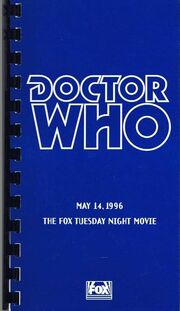
The Press Kit
To promote the film among North American media, Fox issued a presskit consisting of a TARDIS tin containing a VHS of the film, a packet of jelly babies, several black & white photographs, and a small, coil-bound press booklet detailing the film and also explaining a bit of the history of Doctor Who.
Contents[]
- Introduction, a brief explanation of the film and the concept.
- Main credits: This is the only place where Paul McGann and Sylvester McCoy are actually credited as The Doctor and The Old Doctor, respectively, or Eric Roberts as The Master, Daphne Ashbrook as Grace Holloway, and Yee Jee Tso as Chang Lee, as they are not credited with their character names in the televised film. As in the film, John Debney receives sole music credit, with no reference made to Ron Grainer. Also, although it is common practice for US productions to credit a creator(s) for the characters, no individuals are credited in this way for Doctor Who.
- Production Notes: A primer on the concept of Doctor Who, including explanations of what regeneration is all about, what Time Lords are, The Master, etc., and includes actor comments on their characters.
- About the Production: More on the making of the film, plus a discussion of the new TARDIS design, including a reference to the interior being covered by "round bells" (!).
- History: Brief primer on the history of the series back to 1963.
- Facts: Fast facts about the Doctor and the series. Interestingly, it makes reference to the Guinness Book of Records naming it the world's longest running SF series, even though official recognition of this would not occur until 2007. According to this section, the TV movie is the 696th instalment of the television series.
- Biographies: cast and crew biographies for the main actors.
Technical information[]
This movie was shot on 35mm film, transferred to 525i60 Digital Betacam and edited. The finished master is 525i60 Digital Betacam.[3] The BBC owns 525i60 upconversion of this on Digital Betacam and on D3 Videotape. Universal Pictures only holds film trims in its archive.
External links[]
- The TV Movie at the BBC's official site
- Doctor Who (The Movie) at RadioTimes
- Doctor Who at BroaDWcast
- Doctor Who at the Doctor Who Reference Guide
- The Movie at Chrissie's Transcripts Site
- Doctor Who 1996 (aka Enemy Within at Shannon Sullivan's A Brief History of Time (Travel)
- Doctor Who at The Locations Guide
- The Discontinuity Guide Doctor Who page
- Newspaper and magazine articles at the Doctor Who Cuttings Archive
- Film information at Universal Studios
Footnotes[]
Notes[]
References[]
- ↑ UK final ratings
- ↑ Share is the percentage of television sets in use at the time that were tuned to the programmme [1]
- ↑ The Kaleidoscope British Christmas Television Guide 1937-2013.
| ||||||||||||||||||||||||||||||||||||||||||||||||||||||||||||||||||||||||||||||||||||||||||||||||||||||||||||||||||||||||||||||||||||||||||||||||||||||||||||||||||||||||||||||||||||||||||||||||||||||||||||||||||||||||||||
| |||||||||||||||||||||||||||||||||||||||||||||||||||||||||||||||||

